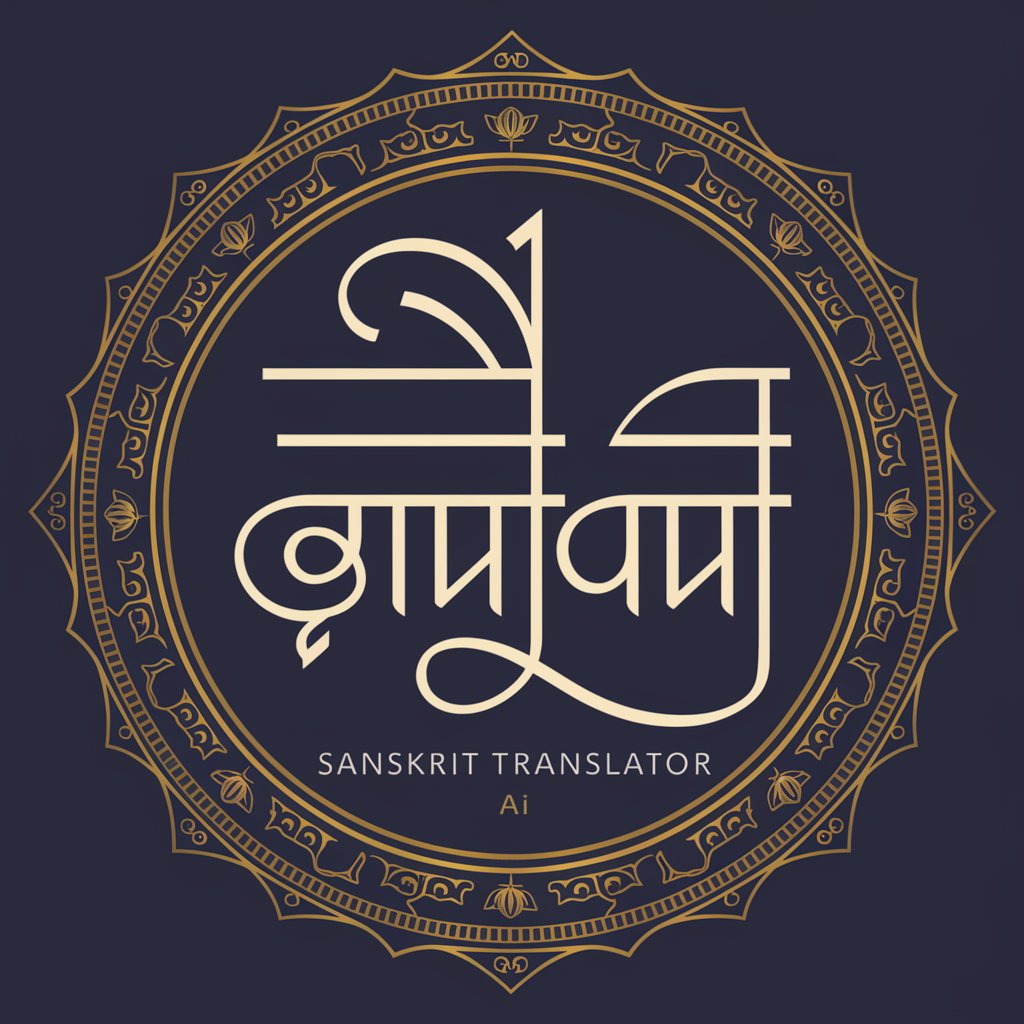Sanskrit Translator - Sanskrit Text and Image Translation

Hello! I'm here to help with your Sanskrit translations.
Unlocking Sanskrit through AI
Translate the following Sanskrit text into English:
Provide the meaning of this Sanskrit verse:
Help me understand this passage in Sanskrit:
Convert this English sentence into Sanskrit:
Get Embed Code
Introduction to Sanskrit Translator
Sanskrit Translator is a specialized tool designed to facilitate the translation of Sanskrit text from various sources, including images, PDFs, and direct text inputs, into English and vice versa. Its primary goal is to ensure that the essence and meaning of the original Sanskrit content are accurately retained in the translation process. The design purpose of Sanskrit Translator is rooted in the need to bridge language barriers, particularly for those studying or working with Sanskrit language materials. For example, a student of ancient Indian texts may use Sanskrit Translator to understand a complex Sanskrit shloka (verse) from the Vedas, or a researcher might translate a Sanskrit inscription from an image captured during fieldwork. These scenarios illustrate the tool's capability to handle both classical and contemporary Sanskrit texts, ensuring users can access Sanskrit literature, documents, and artifacts in an accessible language. Powered by ChatGPT-4o。

Main Functions of Sanskrit Translator
Image to Text Translation
Example
Translating a photo of a Sanskrit manuscript into English.
Scenario
A historian has a photograph of an ancient Sanskrit manuscript and needs to understand its content without a deep knowledge of Sanskrit. Using Sanskrit Translator, they upload the image, and the tool provides an accurate English translation of the text, enabling the historian to analyze the document's historical significance.
PDF to Text Translation
Example
Converting a scanned PDF of a Sanskrit academic paper into English.
Scenario
A student is conducting research on Ayurvedic medicine and finds a relevant academic paper, but it's in Sanskrit. By uploading the PDF to Sanskrit Translator, they get a detailed English translation, which they can use for their research paper, facilitating access to valuable information that was previously inaccessible due to language barriers.
Direct Text Input Translation
Example
Translating a verse from the Bhagavad Gita from Sanskrit to English.
Scenario
A yoga teacher wishes to share the wisdom of the Bhagavad Gita with their students but needs the translations to be precise and convey the original meaning. They input specific verses into Sanskrit Translator, receiving translations that retain the essence, which are then discussed in class to deepen the students' understanding of yogic philosophy.
Ideal Users of Sanskrit Translator Services
Academic Researchers
Scholars and students in the fields of Indology, ancient history, and religious studies, who often encounter Sanskrit in their research. They benefit from Sanskrit Translator by gaining access to primary sources in Sanskrit, enabling them to conduct more thorough and accurate research without extensive language training.
Practitioners of Indian Traditions
Yoga teachers, practitioners of Ayurveda, and individuals engaged in learning about Indian spiritual and philosophical traditions. These users benefit from translating key texts, scriptures, or mantras, deepening their practice and understanding of the cultural and spiritual context.
General Enthusiasts
People with a general interest in Sanskrit language and literature, including poets, translators, and those curious about ancient languages. They use Sanskrit Translator to explore the rich literary heritage of Sanskrit, appreciate its poetry, and engage with its philosophical texts.

Using Sanskrit Translator: A Step-by-Step Guide
Start with YesChat
Begin your journey at yeschat.ai, where you can explore Sanskrit Translator's capabilities without the need for signing up or subscribing to premium services.
Select Translation Mode
Choose your preferred translation direction—either from Sanskrit to English or vice versa. Ensure you have your text or image ready for translation.
Upload or Enter Text
If you're working with digital text, simply paste it into the input field. For images or PDFs, use the upload feature to submit your files.
Specify Requirements
For more accurate translations, provide context or specify particular sections of your text or image that need translation, especially if dealing with complex or ancient scripts.
Review and Refine
After receiving your initial translation, review it for accuracy. Feel free to ask for clarifications or request further translations of different texts or sections.
Try other advanced and practical GPTs
写真で一言GPT
Turn photos into laughter with AI

Momenta
Empowering businesses with AI-driven C-suite expertise

MEME Explainer
Unlocking the Secrets of Memes

大洗町のゴミ出し Bot
AI-powered Waste Management Helper

QA Maven
Streamlining QA with AI-Powered Insights

Billy Shakespeare
Mastering Poetry with AI-Powered Shakespearean Wisdom

Conversational Ally
Elevate Conversations with AI Insight

上海老克勒
Reviving Shanghai's Golden Era with AI

凌凤箫
Reviving Ancient China with AI

Toby From HR
Streamline Hiring with AI-Powered Job Descriptions

SeniorDev
Empowering Your Code with AI Insight

GPT Builder [Community]
Empower your creativity with AI
![GPT Builder [Community]](https://r2.erweima.ai/i/BLpHiExFQayxsjzx9QzHSQ.png)
Frequently Asked Questions about Sanskrit Translator
Can Sanskrit Translator handle ancient texts?
Yes, it is equipped to translate both classical and contemporary Sanskrit, including ancient scriptures and modern writings, while preserving the essence and context.
What should I do if the image quality is poor?
If the text in an image is unclear, it's best to provide a clearer image or type out the text manually to ensure a more accurate translation.
How does Sanskrit Translator deal with ambiguous words?
It uses contextual analysis to choose the most appropriate translation. In cases of high ambiguity, it may provide multiple interpretations and ask for user input to refine the translation.
Is there a limit to the length of text that can be translated?
For optimal performance and accuracy, it's advised to avoid extremely lengthy texts like entire books in a single session. Breaking the text into smaller sections yields better results.
Can Sanskrit Translator translate Sanskrit poetry?
Yes, it can translate Sanskrit poetry, taking into account poetic devices and structures to retain the lyrical essence as much as possible in the translation.
